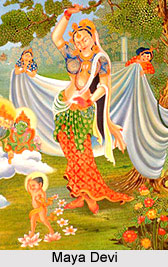 Queen Maya Devi was the mother of Siddhartha or Goutama Buddha. She was the consort of King Suddhodana. Maya is a Sanskrit word, which literally means illusion or enchantment in Sanskrit. Mayadevi was also called Mahamaya. Queen Mayadevi was born in Devadaha kingdom of ancient Nepal.
Queen Maya Devi was the mother of Siddhartha or Goutama Buddha. She was the consort of King Suddhodana. Maya is a Sanskrit word, which literally means illusion or enchantment in Sanskrit. Mayadevi was also called Mahamaya. Queen Mayadevi was born in Devadaha kingdom of ancient Nepal.
Mayadevi was married to King Suddhodana, the ruler of Sakya clan of Kapilavastu. She was the daughter of King Suddhodana`s uncle, who was the king of Devadaha. Therefore Mayadevi was king Suddhodana`s cousin too.
Queen Mayadevi and King Suddhodana did not have child for twenty years in their marriage. According to the legends, one-day queen Maya dreamt of a white elephant entering her side. After this Queen Mayadevi conceived and became pregnant. As the Buddhist scripts say, the Buddha to be was then living in Tushita heaven as Bodhisattva. He decided to take the shape of the white elephant in the earth. Mayadevi gave birth to Siddhartha. She remained pregnant for ten lunar months.
Mayadevi was returning to her parents` home for the birth of the baby. On the way she came down from her palanquin to have a walk in the beautiful flower garden at Lumbini Park. Mayadevi was delighted by the beauty of the park. She stopped for a while to take a rest and reached for a branch of a tree. At this moment Prince Siddhartha was born from her right side. It was full moon night. Mayadevi gave the baby his first bath in the Puskarini pond of the garden. The baby was given the name of Siddhartha. Siddhartha means `one who has accomplished his goal`.
Queen Maya died seven days after the birth of Siddhartha and went to Tushita heaven. Mayadevi`s sister Prajapati became the foster mother of the child.
When Prince Siddhartha became Buddha after attaining enlightenment he visited his mother in heaven for three months to pay her respect and to teach her the Dharma.




















